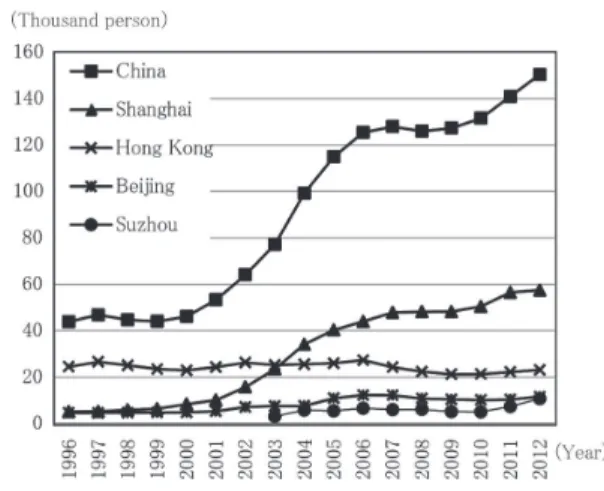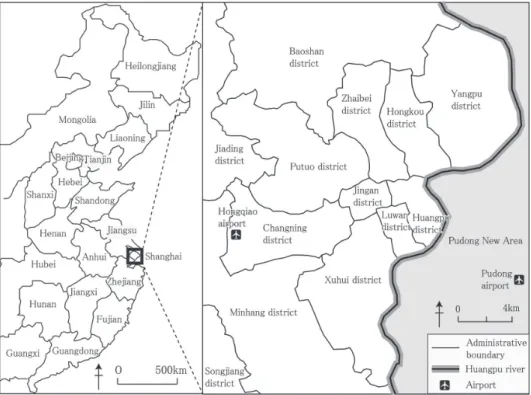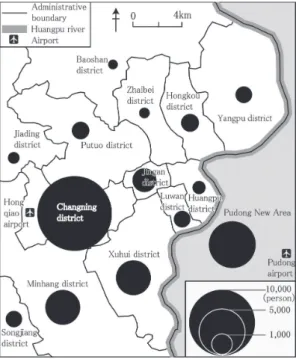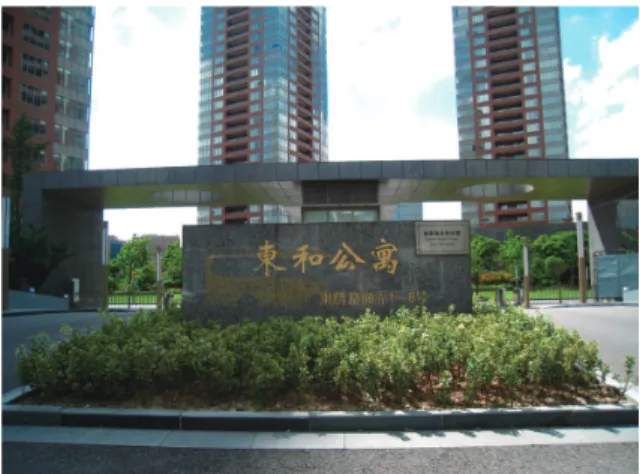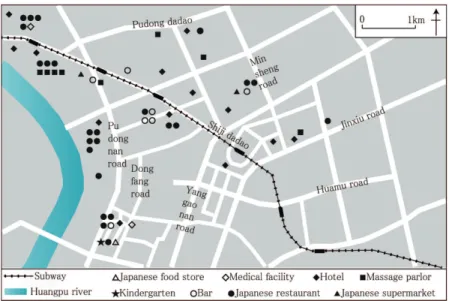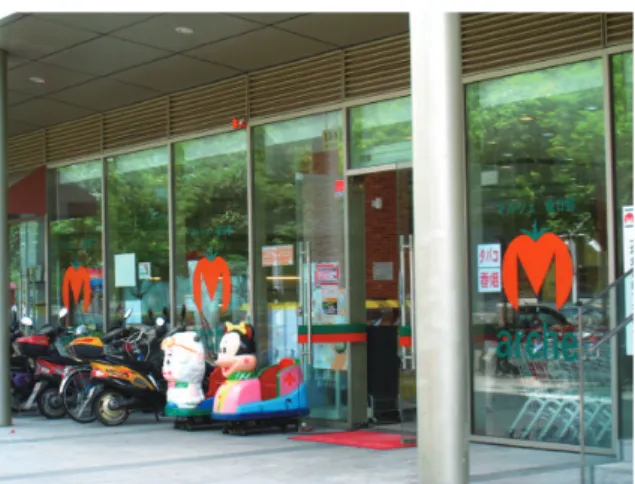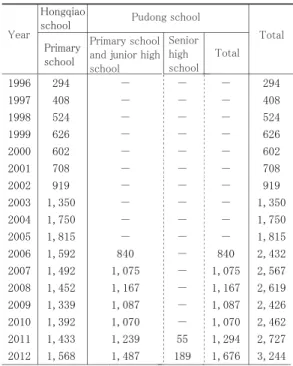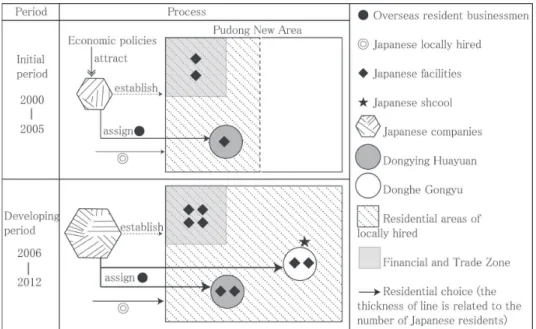Abstract
This study analyzes the development and characteristics of a Japanese enclave in Pudong New Area of Shanghai from two viewpoints: the development of Japanese resi-dences and facilities, and the settlement patterns of Japa-nese expatriates based on their attributes. The number of Japanese expatriates in Shanghai has increased since the 1990s due to higher Japanese investments in Shanghai, and a total of 57,458 Japanese were living in Shanghai in 2012. Within Shanghai, Pudong New Area has the second-high-est number of Japanese expatriates after Gubei. The Japa-nese enclave in Pudong New Area suggests that the local authorities, Japanese companies, and Japanese school play an active role in its formation and development processes. However, the Japanese enclave in Pudong New Area is characterized as a residential space because of the under-development of Japanese-owned facilities, because most self-employed Japanese prefer living and working in Gu-bei.
Key words: Japanese expatriates, ethnic enclave, settle-ment patterns, Pudong New Area, Shanghai
1. Introduction
Since the Japanese post-war economic boom, Japanese migration overseas has become more frequent. Before World War II, many Japanese were migrant laborers, but most Japanese traveling overseas in later times have done so for various reasons, such as studying and getting mar-ried abroad. However, the main reason for traveling abroad has been the assignment by headquarters of Japanese com-panies operating in a global economy (Iwauchi et al., 1992). Since the 2000s, the reasons for going abroad and employ-ment patterns of the Japanese have become complex. Not only are assigned workers (i.e., “overseas resident busi-nessmen” assigned by headquarters of Japanese companies) and their families moving abroad but also Japanese hired by local companies (i.e., “locally hired”) and an increasing number of self-employed. Almost all these Japanese are transients and have moved frequently; in particular, Japa-nese overseas resident businessmen and their families typi-cally stay for several years before being sent for other
as-signments to other countries or (most commonly) returning to Japan. These Japanese migrants are defined as Japanese expatriates in this study.
Japanese expatriates have already been extensively stud-ied from two perspectives. Studies under the first perspec-tive have focused on the characteristics of Japanese com-munities overseas based upon the socioeconomic attributes of Japanese expatriates (Glebe, 2003; Sakai, 2003; Thang
et al., 2002; Nakazawa et al., 2008). Studies under the sec-ond perspective have focused on the formation and trans-formation processes of Japanese enclaves in Western and newly industrializing countries (White, 2003; Machimura, 2003; Ben-Ari, 2003). However, little is known about Japa-nese enclaves in non-English-speaking countries.
China has become one of the most popular destinations for Japanese expatriates since the 2000s. After America, China has accepted the second-highest number of Japanese expatriates since 2003. According to data from the Annual Report of Statistics on Japanese Nationals Overseas, a total of 77,184 Japanese were living in China in 2003 and 150,399 were doing so in 2012; of these, approximately 38.2% (57,458) were living in Shanghai (Fig. 1). Japanese expatriates have mainly migrated to Shanghai since the 1990s: a total of 5,141 Japanese were living in Shanghai in 1996, rising to 10,133 in 2001 and 57,458 in 2012. Since 2011, Shanghai has overtaken New York as the city with the second-highest number of Japanese expatriates in the
* Graduate School of Life and Environmental Sciences,
Uni-versity of Tsukuba
Development and characteristics of the Japanese enclave in Pudong New Area
of Shanghai
Wenting ZHOU*
Fig. 1 Trends in the number of Japanese expatriates in Shanghai, Hong Kong, Beijing and Suzhou, 1996-2012
world after Los Angeles, making Shanghai a significant study area for Japanese expatriates.
To date, there have only been two studies on Japanese expatriates in China. Liu et al. (2010) focused on the daily activities and residential spaces of Japanese expatriates liv-ing in Guangzhou, China. Zhou (2014) examined the for-mation and transforfor-mation processes of Japanese enclave in Gubei area of Shanghai. However, no studies have fo-cused on other Japanese enclaves in Shanghai, which have different characteristics than that of Gubei. Therefore, Pudong New Area in Shanghai, which is a planned area and regarded as an experimental field for internationalization and economic growth (Fig. 2), was chosen as the study area. Pudong New Area has the second-highest number of Japanese expatriates after Gubei in Shanghai, and the Japa-nese population there has continued to grow owing to in-creases in Japanese investments in the area.
This study examines the development and characteristics of the Japanese enclave in Pudong New Area of Shanghai based on two aspects: (1) the development of Japanese resi-dences and facilities, and (2) the settlement patterns of Jap-anese expatriates based on their attributes. Firsthand data from the Japanese enclave in Pudong New Area were main-ly gathered through fieldwork because of the difficulty in obtaining and analyzing foreign population censuses in China. Fieldwork was conducted in March, July, and Au-gust 2012 and in February and March 2013. First, I ana-lyzed the data from Japanese magazines such as Whenever Shanghai (1999–2013), newspapers, and homepages for
Japanese expatriates. Three Japanese people were inter-viewed to gather basic information about Japanese resi-dences and facilities: one was a Japanese real-estate agent who had worked in Shanghai for over 10 years, and the other two were Japanese academic staff. Third, 13 Japanese were surveyed based on their essential attributes, including migration experiences, householders’ employment condi-tions and income, and duration of stay in Shanghai.
2. Background: economic growth in Shanghai and pull-ing in Japanese investments
Pudong New Area, lying to the east of Huangpu River in the Shanghai municipal region and covering an area of 533 km2, has seen a remarkable transformation since the
Chinese government formally announced plans for large-scale development in 1990 (Andrew et al., 2006). With this, many manufacturers, offices, and companies in the finan-cial, information technology, electronic, and chemical sec-tors have been established in Pudong New Area, and this area became more easily accessible with the operation of Pudong International Airport in 1999. Since the 2000s, in order to build Pudong New Area into an export-oriented, multi-functional, and modernized new district by the year 2020, various important principles and some specific mea-sures have been implemented for the area’s development. In terms of industrial development, priorities have been given to finance, trade and advanced services, high tech-nology, and tourism, with a focus on large investors, espe-cially foreign direct investment (FDI) from advanced
tries and regions that have been used to boost economic growth and accelerate industrial development in Pudong New Area. Simultaneously, the industrial and residential infrastructures of Pudong New Area have also been focused on, and many preferential customs policies have been pro-mulgated in order to attract further FDI. As a result, the number of multinational manufacturers, offices, and com-panies has increased sharply in the area. In 2005, the in-vestment environment for financial functions in both hard-ware and softhard-ware were improved in order to increase the number of international financial institutions, corporate headquarters, and R&D departments. In addition, multina-tional financial and logistics industries in other districts have been required to move to Pudong New Area since 2005. Consequently, Pudong New Area has become one of the most popular destinations for FDI in Shanghai.
An influx of FDI is found to boost economic growth; therefore, in Shanghai, business promotion and attracting foreign funds are the top priorities for the development of Pudong New Area. According to data from the Pudong New Area Statistics Department, Fig. 3 shows a steady in-crease of FDI in Pudong New Area from 1992 to 2012. In 1992, Pudong New Area accepted 738 FDI contracted
proj-ects and USD 1.6 billion of FDI contracted value capital: the former accounted for 22.4% of FDI contracted projects, and the latter comprised 23.5% of FDI contracted value capital in Shanghai. In 2012, the number of FDI contracted projects has increased 28 times from 738 to 20,624, and FDI contracted value capital has increased 45 times to ex-ceed USD 70.7 billion: the former accounted for 30.4% of overall FDI contracts projects, and the latter comprised 32.5% of FDI contracted value capital in Shanghai in 2012.
Fig. 4 shows FDI in Pudong New Area by country/region in 2012. The FDI contracted projects in Pudong New Area from Hong Kong accounted for 28.6% of the total, Japan 13.2%, America 11.3%, Taiwan 6.1%, Singapore 5.9%, Korea 2.9%, and other regions 32.0% of the total number of FDI contracted projects. On the other hand, the FDI con-tracted value capital in Pudong New Area from Hong Kong accounted for 25.9% of the total, Japan 11.1%, America 9.7%, Singapore 6.2%, Taiwan 1.1%, Korea 1.3%, and oth-er regions 44.7% of the total. Thus, from the above statis-tics, it is clear that the Japanese investments after Hong Kong were one of the main contributors to the growth of FDI in Pudong New Area. Fig. 5 shows the increase in Jap-anese investments in Pudong New Area since 1992. From 1992 to 2012, the number of Japanese contracted projects has increased from 68 to 2,727, an increase of 40 times in 20 years. The Japanese contracted value capital has in-creased from USD 0.8 billion in 1997 to USD 7.9 billion in 2012, an increase of 10 times in 15 years.
Japanese investments in Pudong New Area have contrib-uted to a promising job market, which has attracted an in-creasing Japanese population into the area. Concurrently, Article No.122 was published in 2002, according to which the focus was extended from FDI to attracting human re-sources from other domestic regions (explicitly defined as talent with a bachelor’s degree or above or specialists). For instance, a total of 5,141 Japanese expatriates were living in Shanghai in 1996; this number rose to 10,133 in 2001
Fig. 3 Increase of foreign direct investment in Pudong New Area from 1992 to 2012
(Source: Shanghai Pudong New Area Statistical Yearbook. 1993-2013)
and 57,458 in 2012. According to data from the Tabulation on the 2010 Population Census of Shanghai Municipality, around 16.9% (5,026) of Japanese expatriates were living in Pudong New Area (Fig. 6). This settlement pattern re-flects an emerging spatial residential segregation, which is related to the formation of the Japanese enclave. In addi-tion, this settlement pattern reveals the significance of Pudong New Area as a study area on Japanese enclaves.
3. Development of a Japanese enclave: case study of Pudong New Area
Many Japanese expatriates moved to Pudong New Area in the 2000s after receiving permission from the authorities to live outside the foreign residences of Gubei. This chapter
focuses on the development of the Japanese enclave in Pudong New Area on the basis of Japanese residences and facilities in two periods: the initial period (2000–2005) and the developing period (2006–2012). In the initial period, there were few Japanese expatriates living in Pudong; how-ever, the population has greatly increased after 2005. The main causes of this increased Japanese population were changes to economic policies of China and Shanghai and the establishment of a Japanese school, both of which have led to the rapid development of the Japanese enclave.
3.1. Japanese residences in Pudong
To understand the extent of the Japanese enclave in Pudong New Area, residences with a significant number of Japanese residents were selected for this study based on in-terviews with Japanese real-estate agents and residents in the area. The chosen Japanese residences were mainly ser-vice apartments, which are the main preferred accommoda-tion for Japanese expatriates living in Shanghai. The Japa-nese residences were classified into two categories according to the monthly house rent and occupational sta-tus of the Japanese residents (Table 1).
The first category of Japanese residences consists of two residences named Dongying Huayuan and Donghe Gongyu, which target Japanese overseas resident businessmen in particular. Dongying Huayuan is the only residence to be built by a Japanese real-estate agent in Shanghai and is lo-cated close to many Japanese companies to attract more Japanese residents. Donghe Gongyu (Fig. 7) was built by a Chinese real-estate agent and is located near Shiji Park and the Japanese school (about a 5–minute walk) on the path linking Pudong International Airport to the city core. Both Dongying Huayuan and Donghe Gongyu are luxury-gated estates that provide various services for the Japanese resi-dents, such as subscriptions to Japanese newspapers and magazines, foreign currency exchange, availability of golf courses and Japanese TV programs, shuttle buses to the Japanese school and shopping centers, and house-cleaning services. With such a range of service provision, the rent
Fig. 5 Increase of Japanese investments in Pudong New Area from 1992 to 2012
(Source: Shanghai Pudong New Area Statistical Yearbook, 1993-2013)
Fig. 6 Distribution of Japanese expatriates in the urban center of Shanghai, 2010
(Source: Tabulation on the 2010 Population Census of Shanghai Municipality. Zhou, 2014)
reaches JPY 255,000 per month1). As a result, the wealthy,
that is, mainly Japanese professionals, managers, and busi-ness owners, tend to move into these two residences. Par-ticularly, the majority of the Japanese residents in these residences are overseas resident businessmen, who do not face economic constraints on their residential choices be-cause they receive rich housing allowances from their Japa-nese companies.
The second category consists of nine residences with an average house rent of JPY 101,000 per month. Although they are considered Japanese residences, other ethnic popu-lations and Chinese also live in these residences. Eight of these residences were built between 2002 and 2005, and one was built after 2005. All of these Japanese residences are located near the Japanese business center, from the southeast of Lujiazhui Financial and Trade Zone to Shiji Park (Fig. 8).
The distribution pattern of the Japanese residences shows that a majority of the Japanese overseas resident business-men prefer specific types of residences, such as Dongying
Huayuan and Donghe Gongyu, while other Japanese are scattered in other residences.
3.2. Japanese facilities in Pudong
Japanese facilities are classified into four categories: ed-ucational facilities, grocery facilities, catering facilities, and others in this study.
In 2005, the Japanese facilities were distributed mainly in and around Lujiazhui Financial and Trade Zone and Dongying Huayuan (Fig. 9), because the former is a Japa-nese business center where many JapaJapa-nese expatriates work and the latter is a Japanese residence. Facilities that existed in 2005 were as follows: 1 educational facility (i.e., the Japanese kindergarten); 3 grocery facilities, including 1 Japanese food store and 2 Japanese supermarkets; 31 cater-ing facilities (the category with the highest number of fa-cilities), including 24 Japanese restaurants and 7 bars; and a total of 23 other facilities, comprising 2 medical facilities, 8 massage parlors, and 13 hotels2).
By 2012, the spatial distribution of Japanese facilities changed. First, the number of facilities increased in and around Lujiazhui Financial and Trade Zone and Dongying Huayuan, and second, more Japanese facilities were estab-lished in and around new Japanese residences, such as Donghe Gongyu (Fig. 10). These changes reveal that Japa-nese facilities had a highly localized distribution within and around both the Japanese business center and Japanese res-idences in 2005 and 2012. In 2012, Japanese facilities were as follows: educational facilities increased to 10, including 1 Japanese school (Fig. 11), 3 kindergartens (Fig. 12), and 6 cram schools/interest classes (Fig. 13); 7 grocery facili-ties were opened, bringing the total to 10, including 2 su-permarkets (Fig. 14), 1 hypermarket, and 7 food stores; all catering facilities became Japanese restaurants (Fig. 15) for a total of 39 (because Japanese restaurants replaced
shut-Fig. 7 Japanese residence for overseas resident businessmen: Donghe Gongyu
Fig. 10 Distribution of the Japanese facilities in Pudong New Area, 2012 (Source: Whenever Shanghai, March 2012 and fieldwork in 2012)
Fig. 11 Japanese school in Pudong New Area Fig. 12 Japanese kindergarten in Pudong New Area Fig. 9 Distribution of the Japanese facilities in Pudong New Area, 2005
tered bars); and finally, 31 other facilities existed, including 4 medical facilities (Fig. 16), 2 real-estate agents, 4 mas-sage parlors, 7 beauty salons, and 14 hotels.
Although the number of Japanese facilities in Pudong has increased, most are managed by the local Chinese; in other words, many Japanese facilities are Chinese-owned. However, Chinese proprietors have found it difficult to re-spond to the demand for Japanese-style services, and thus, some Japanese residents prefer to utilize the Japanese-owned facilities in Gubei. For example, Interviewee No. 1 (Table 2) usually buys Japanese food and sauces from Japa-nese supermarkets, and vegetables and meat from the Car-refour hypermarket in Gubei even though she lives in Pudong. Shopping in Gubei is convenient for her, because she has had a part-time job in a Japanese nursery in Gubei since 2010 (Fig. 17). She occasionally shops at Pudong’s Japanese food stores, but she is dissatisfied with the fresh-ness and variety of the food.
3.3. The Japanese school in Pudong
Until 2005, only one Japanese school provided primary education in Shanghai, which resulted in three problems:
(1) Japanese whose children studied in secondary school had to live apart from their families in Shanghai; (2) the Japanese had to send their children back to Japan when they finished primary education in Shanghai; and (3) edu-cational resources became insufficient to accommodate the increase in the number of Japanese students. These prob-lems were resolved with the establishment of the Japanese school in Pudong New Area in 2006, which provides both primary and secondary education.
The number of Japanese students in the Japanese school in Pudong was 840 in 2006, rising to 1,676 in 2012: the former accounted for 34.5% of the total Japanese student population in Shanghai and the latter 51.7% (Table 3). This illustrates the importance of the Japanese school in Pudong among all Japanese educational facilities, because the Japa-nese students must have access to the JapaJapa-nese education in non-English-speaking countries. Therefore, the presence of a Japanese school has had a positive impact on both Japa-nese residential choices and JapaJapa-nese companies’ site se-lection. Moreover, the land used for the Japanese school is provided for free by a Chinese real-estate agent with the purpose of attracting more Japanese residents to the
resi-Fig. 13 Advertisements of Cram schools for Japanese students Fig. 14 Japanese supermarket in Pudong New Area
dences (Donghe Gongyu) owned by the agent.
Many of the interviewed Japanese expatriates indicated that they preferred to choose residences with easy access to the Japanese school. For example, Interviewee No. 3 is a Japanese man in his 40s who lives with his wife and two children, ages 9 and 14. They first lived in Changning dis-trict near his workplace, but they moved to Pudong New Area in 2012 after enrolling their elder child in Japanese
secondary school. Consequently, their younger child was transferred from the Japanese school in Gubei to that in Pudong.
Table 2. Attributes of Japanese expatriates in Pudong New Area extrapolated from the questionnaires
Fig. 17 Interviewee No.1: Japanese academic staff
4. Settlement patterns of Japanese expatriates 4.1. Classification of Japanese expatriates
The classification and settlement patterns of Japanese expatriates are discussed using data mainly gathered through interviews.
Interviewee No. 1 is a Japanese housewife who accom-panied her husband who was assigned to Shanghai by a Japanese company. She witnessed the development of the Japanese enclaves in Shanghai, as she spent over 10 years living in Gubei and Pudong New Area. She pointed out that among the Japanese population in Pudong, the overseas resident businessmen and their families are the largest sub-group. Furthermore, the locally hired are the second-largest group and have been increasing in numbers since 2008. However, recently, some self-employed Japanese have con-sidered establishing Japanese facilities in Pudong New Area.
4.2. Overseas resident businessmen
Since the 2000s, the opening up of the Chinese market has resulted in a rapid expansion of inflowing Japanese professional and managerial labor as well as business own-ers. This has ultimately led to the establishment of Dongy-ing Huayuan and Donghe Gongyu, which provide residen-tial properties for Japanese expatriates who work in Pudong New Area. These two residences target Japanese overseas resident businessmen in particular because of their high fi-nancial status resulting from their high occupational posi-tion.
Dongying Huayuan and Donghe Gongyu are the two largest Japanese residences in Pudong New Area. There were 466 Japanese households in Dongying Huayuan and 413 in Donghe Gongyu in March 2013. According to the data in Table 4, the average size of foreign families in Pudong New Area is 2.2, implying that there are about 1,950 Japanese living in the two Japanese residences, ac-counting for 24.1% of the total Japanese population in Pudong. From the interviews, it is clear that many Japanese choose to live there because of the accessibility to Japanese facilities and easy access to work and Japanese school.
For example, Interviewee No. 5 is a Japanese overseas resident businessman in his 30s who has lived with his fam-ily in Pudong since 2012. Accessibility to Japanese facili-ties was a top priority in his residential choices, as his chil-dren are young (ages 4 and 7) and his wife is not proficient in Chinese. Thus, No. 5 chose to settle in Dongying Hua-yuan, which is well-equipped with Japanese facilities such as a Japanese kindergarten, convenience stores, restaurants, and shuttle buses to the Japanese school and Gubei. How-ever, No. 5 also believes it is comparatively expensive liv-ing for Japanese other than overseas resident businessmen, as rents reach JPY 300,000 per month.
However, not all Japanese overseas resident business-men can afford such high rent, as there are class differences within the overseas resident businessmen group based on their socioeconomic status and rent-paying ability.
Interviewee No. 6 pointed out that the socioeconomic status of overseas resident businessmen in Shanghai has become more diverse. No. 6 spent 3 years in Beijing as an overseas resident businessman in a Japanese company be-tween 1994 and 1996, returning to China after his retire-ment in 2003. Since then, he has performed a variety of work in both Chinese and Japanese companies. From such living and working experience, No.6 has became familiar with both Chinese and Japanese societies. Through the in-terview of No.6, I inferred that although the number of overseas resident businessmen and their families increased in Shanghai, those who came later were relatively younger: the majority of the overseas resident businessmen assigned in the early 2000s were in their 50s and 60s, while those in the late 2000s were in their 30s and 40s. Because of their younger age, these overseas resident businessmen receive fewer allowances from Japanese companies and are more likely to hold less-important positions, which has affected their residential choices.
Those of a lower socioeconomic status, fewer allowanc-es, and lower salaries prefer to live in other types of Japa-nese residences or even ChiJapa-nese ones. They value easy ac-cess to work rather than Japanese facilities. The period of stay in Shanghai and fluency in Chinese also affect the
dential choices of such Japanese, which should also be con-sidered when studying Japanese residential choices.
For example, Interviewee No. 1 lives in a Chinese resi-dence with a rent of JPY 80,000 per month, which is paid entirely by her husband’s company. She is comfortable liv-ing in a Chinese residence, because she has lived in Shang-hai for over 10 years and is fluent in Chinese. As there are no Japanese broadcast TV programs, No. 1 and her family watch Chinese TV programs or Japanese DVDs bought from Gubei. In fact, most of her daily activities are in Gu-bei, but she lives in Pudong because it is convenient for her husband to commute to work.
These examples show that not all Japanese overseas resi-dent businessmen experienced the same economic condi-tions with regard to their salaries and allowances. Since 2003, the allowances paid by Japanese companies have been reduced as management costs have been cut. Taking the housing allowances as an example, it is common for the Japanese companies to currently pay 30–70% of their em-ployees’ rent instead of the total amount paid before 2003. Therefore, overseas resident businessmen living in Pudong are further classified into two categories based on their so-cioeconomic status: Group 1 is wealthy and lives in Don-gying Huayuan and Donghe Gongyu; and Group 2 has a comparatively lower income and lives in other, cheaper residences.
4.3. The locally hired
The increase in Japanese companies in Pudong New Area since 2005 has persuaded more locally hired Japanese to live and work there because of the job and employment opportunities available. Most are young and in their 20s
and 30s, working mainly in Japanese and Chinese compa-nies and in Japanese facilities. They have different charac-teristics based on their employment status: most employees of Japanese companies are salesmen of Japanese commodi-ties from Japan. Employees of Chinese companies are more likely to be responsible for quality management, technical advice, and management systems in order to maintain friendly associations with Japanese companies. Employees of Japanese facilities provide Japanese-style services be-cause of having an understanding of Japanese tradition and culture.
Locally hired Japanese look for easy access to work and low rent when choosing their residences. Unlike the over-seas resident businessmen who are concentrated in specific types of Japanese residences, the locally hired are scattered in many Japanese and Chinese residences.
For example, Interviewee No. 6 moved from a Chinese company in Dalian city to a Japanese translation company in Shanghai in 2004 for better work opportunities, receiv-ing a house provided by that company for free. In 2005, he shifted again when he took a new job in a Japanese com-mercial company. Because the company stopped paying rent for employees in 2006, he began living in a Chinese residence. One reason for this choice was the low rent. Rent has remained unchanged despite the large increase in living costs over recent years, mainly because landlords prefer to rent out rooms to the Japanese who always keep them clean. Another reason is easy access to the subway station. However, No. 6 uses local markets and Chinese supermar-kets because of the lack of Japanese facilities, so he prefers to buy Japanese food and sauces from Japan.
Although lower rent is a major consideration when
choosing residence, some locally hired Japanese prefer to live in Japanese residences for residential security. No. 7, 8, 9, 10, 11, and 12 live in dormitories provided by Japanese companies and facilities, paying either part of their rent or none at all.
5. Conclusion
In this study, development processes of the Japanese en-clave in Pudong New Area were examined in two periods: the initial period (2000–2005) and the developing period (2006–2012) (Fig. 18). In the initial period, with China’s entry into the World Trade Organization, Pudong New Area became one of the most popular investment destinations for the Japanese, which led to the increase in Japanese compa-nies and Japanese employees. The main Japanese popula-tion group in Pudong New Area was overseas resident busi-nessmen assigned from Japan, the majority of whose residences were arranged in Dongying Huayuan in this pe-riod by the Japanese companies. As a result, the largest Japanese residence was formed, and it became the origin of the Japanese enclave in Pudong New Area. In addition to Dongying Huayuan, some Japanese lived in other, smaller Japanese residences around Dongying Huayuan and in Lu-jiazhui Financial and Trade Zone. Although few in number, Japanese facilities increased slowly with the development of these residences.
In the developing period, Japanese companies and expa-triates have expanded in Pudong New Area due to the open-ing up of Chinese market and alterations in Shanghai’s eco-nomic policies. This has led to the establishment of one more Japanese school and Japanese residence, that is, Donghe Gongyu, to provide for Japanese students and meet population growth. Pudong New Area has become more easily accessible with the operation of Subway line 4, 6, and 9. However, it is difficult for locally hired Japanese to live in the same residences as overseas resident business-men because of the economic constraints on their residen-tial choices. Locally hired Japanese therefore prefer to live in residences near those for Japanese overseas resident businessmen. This has led to the expansion of Pudong en-clave, with Japanese residences for overseas resident busi-nessmen in the central area and those for the locally hired on the outskirts of the area. However, Japanese-owned fa-cilities have been localized mainly in Dongying Huayuan, Donghe Gongyu, and Lujiazhui Financial and Trade Zone, where their main customers, Japanese overseas resident businessmen and their families are concentrated.
There are two characteristics of the Japanese enclave in Pudong New Area.
First, the local authorities and Japanese companies have had a key role in the initial period of Japanese enclave velopment. Since the 2000s, the local authorities have
de-signed and implemented corresponding strategies to attract foreign investment to stimulate economic growth, under which Pudong New Area has developed into a multination-al industrimultination-al district where many Japanese companies have been established. As a result, Japanese-invested companies have been encouraged to locate in Pudong New Area. Par-allel to the increasing number of Japanese-invested compa-nies, growth in the number of Japanese expatriates was pre-dicted, the majority of whose accommodations were provided by the Japanese companies. Thus, the majority of Japanese have lived in the Japanese residences. In addition, the residential concentration has helped the Japanese adapt to the local lifestyle and more easily overcome the language and cultural barriers.
Second, the Japanese school has played a major role in the development of the Japanese enclave, as the Japanese children’s education is a top priority in residential choices for the Japanese. The Japanese focus on the Japanese school, because it is necessary for the Japanese children to receive a good education compared to those in English-speaking countries. As a result, many Japanese with chil-dren prefer to live in residences near the Japanese school. Besides the educational facilities, many other Japanese fa-cilities in Pudong New Area are managed by the Chinese, who cannot satisfy Japanese demand. In other words, there is a limit in the number and quality of other types of nese facilities. Thus, for further development of the Japa-nese enclave in Pudong New Area, it is necessary to con-sider how to bridge the Japanese demand and supply gap.
Note
1) In this study, 1 RMB is equivalent to 12 JPY based upon the exchange rate in March 2012.
2) The Japanese traveling to Pudong New Area for busi-ness live in hotels.
References
Andrew, M. M. and Wei, W. (2006): Spaces of globaliza-tion: Institutional reforms and spatial economic devel-opment in the Pudong new area, Shanghai. Habitat International, 2, 213–229.
Ben-Ari, E. (2003): The Japanese in Singapore: the dy-namics of an expatriate community. In Goodman, R. ed., Global Japan: The Experience of Japan’s New Immigrants and Overseas Communities. Routledge, 116–130.
Glebe, G. (2003): Segregation and the ethnoscape: the Jap-anese business community in Düsseldorf. In Good-man, R. ed., Global Japan: The Experience of Japan’s New Immigrants and Overseas Communities. Rout-ledge, 98–115.
The management of Japanese companies overseas and the life of Japanese overseas resident business-men. Dobunkan, 1–14.
Liu, Y., Tan, Y., and Zhou, W. (2010): Japanese expatriates in Guangzhou city: the activity and living space. Acta Geographica Sinica, 65, 1173–1186.
Machimura, T. (2003): Living in a transnational commu-nity within a multiple-ethnic city: making a localized ‘Japan’ in Los Angeles. In Goodman, R. ed., Global Japan: The Experience of Japan’s New Immigrants and Overseas Communities. Routledge, 147–156. Nakazawa, T., Yui, Y., Kamiya, H. and Takezada, Y. (2008):
Experience of international migration and Japanese identity: a study of locally hired Japanese women in Singapore. Geographical Review of Japan Series A,
81, 95–120.
Sakai, C. (2003): The Japanese community in Hong Kong in the 1990s: the diversity of strategies and intentions.
In Goodman, R. ed., Global Japan: The Experience of Japan’s New Immigrants and Overseas Communities.
Routledge, 131–146.
Thang, L. L., MacLachlan, E. and Goda, M. (2002): Expa-triates on the margins: a study of Japanese women working in Singapore. Geoforum, 33, 539–551. White, P. (2003): The Japanese in London: from transience
to settlement. In Goodman, R. ed., Global Japan: The Experience of Japan’s New Immigrants and Overseas Communities. Routledge, 79–97.
Zhou, W. (2014): Formation and transformation processes of a Japanese enclave in Shanghai: case study of the Gubei area. Geographical Review of Japan Series A,
87, 183–204.
